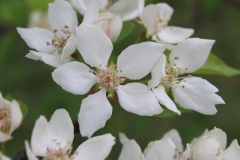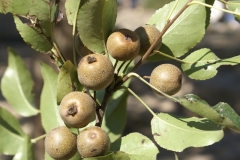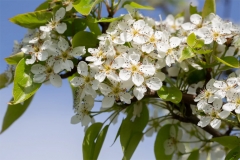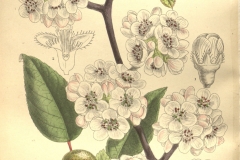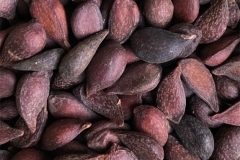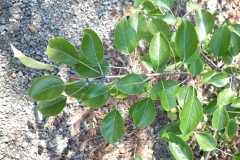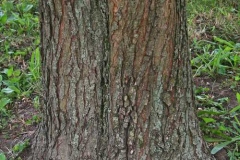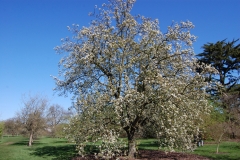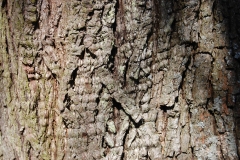| Himalayan pear Quick Facts | |
|---|---|
| Name: | Himalayan pear |
| Scientific Name: | Pyrus pashia |
| Origin | Distributed across the Himalayas, from Pakistan to Vietnam and from southern province of China to the northern region of India |
| Colors | Initially green turning to yellowish-green color when ripe |
| Shapes | Small pear-shaped fruits that are edible |
| Taste | Sweet and slightly tangy flavor |
| Health benefits | Vitamins and Minerals, Antioxidants, Digestive health, Promotes Healthy Gut, Good for Immunity, Maintain Blood Pressure, Support Cardiovascular Function, Enhance Skin Radiance, Curb Unhealthy Snacking, Reduce Cholesterol Levels, Anti-aging Benefits, Improves Skin Texture, Supports Healthy Metabolism, Antimicrobial Properties |
| Name | Himalayan pear |
|---|---|
| Scientific Name | Pyrus pashia |
| Native | Distributed across the Himalayas, from Pakistan to Vietnam and from southern province of China to the northern region of India. It is also found in Nepal, Bhutan, Kashmir, Iran and Afghanistan |
| Common Names | Wild Himalayan pear, Indian pear, Nepalese pear, Nepal pear, Himalayan wild pear, Pyrus calleryana Himalayan, Pashia pear, Chalpat pear |
| Name in Other Languages | Assamese: Kantha (কাংথ) Bengali: Kedara (কেদার), Chhota Nashpati (ছোট নাশপাতি) Bodo: Kainth, Khejuri Bulgarian: Afganistanska krusha (Афганистанска круша) Chinese: Xǐmǎlāyǎ lí (喜马拉雅梨), Chuan li (川梨), Shānlihóng (山里红), Chuān lí jīng pí (川梨茎皮), Táng líhuā (棠梨花), Táng lí (chuān lí) (棠梨(川梨) Dutch: Himalaya-peer English: Himalayan pear, Wild Himalayan pear, Indian pear, Nepalese pear, Nepal pear, Himalayan wild pear, Pyrus calleryana Himalayan, Pashia pear French: Poire de l’Himalaya German: Himalaya-Birne, Himalaja-Birnbaum Gujarati: Kithela (કિઠેલા), Narkath (નરકથ) Hindi: Kainth (कैंठ), Kainthola (केंथौला), Kainthola Choti (कैंठोला छोटी), (Kangoo (कांगू), Khojat (खोजात), Khejuri (खेजुरी), Basane Kainth (बसने कैंठ), mayal, meb, mehal, mol Indonesia: Apel jepang Italian: Pera dell’Himalaya Japanese: Himarayanashi (ヒマラヤナシ), Perasu pashia (ピルス・パシア) Kannada: Kaiphal (ಕೈಫಲ), Kaiphalanera (ಕೈಫಲನೇರ) Kashmiri: Kainth, Khejri Khasi: Soh jhur Konkani: Kainth, Kainthola Korean: Himalaya bae (히말라야 배) Malayalam: Kaiphal (കൈഫൽ), Asan (അസാൻ) Malaysia: Lai Maithili: Kainth, Kainthola Manipuri: Kainth, Khejuri Marathi: Kainth (कैंथ), Moris (मोरिस) Mizo: Chalthei, Vul Nepali: Kaiphal (कैफल), Kainthola (कैंठोला), Khejuri (खेजुरी), (Asan (असान), Chhota Kainth (छोटो कैंठ) , mayal (मयल) Odia: Kainth, Chota Nashpati Philippines: Peras Portuguese: Pera do Himalaia Punjabi: Kainth (ਕੈਂਠ), Kanhotti (ਕਨ੍ਹੋਟੀ), Khejuri (ਖੇਜੂਰ), Maror Phal (ਮਰੋਰ ਫਲ) Russian: Himalayskaya grusha (Гималайская груша), Dikaya grusha (Дикая груша), Grusha dikaya (Груша дикая) Santali: Kainth, Khejuri Sindhi: Kainth, Khojat Sinhala: Kumburu Nera (කුඹුරු නේරා), Asan (අසන්) Spanish: Pera del Himalaya Tamil: (Kaippidiyan Pazham (கைப்பிடியான்பழம்), Asan (அசன்) Telugu: Kedaramu (కెదరము), Maroru (మరోరు) Thai: Lukkaeo Himalai (ลูกแก้วหิมาลัย), sali Tibetan: Lhung Yul (ལྷུང་ཡུལ་) Urdu: Kainth (کینٹھ), Umaria (اُمریہ) Vietnamese: Lê Himalaya, le |
| Plant Growth Habit | Small to medium size, enchanting, deciduous tree |
| Growing Climates | In valleys, hillsides, open forests, lower forest edge, slopes, meadows, near rice paddy fields, open shrub land, near small streams or swamp areas |
| Soil | Prefers well-draining soil that is rich in organic matter. The soil should have good water retention capacity while allowing excess water to drain away |
| Plant Size | 6 to 10 meters (20 to 33 ft) tall and 6 meters (20 ft) wide |
| Root | Grows a taproot that goes straight down into the ground. The main anchor of the tree is the taproot, which gives it structure and support |
| Stem | Himalayan Pear’s main stem, the trunk, goes from the base of the tree up. It gives the tree structure and sturdiness, which helps it stand up to wind and other forces |
| Bark | When the tree is young, the bark is mostly smooth. As the tree gets older, its bark gets rougher and splits and bumps along its length |
| Leaf | Simple, alternate, and ovate in shape. They exhibit a shiny dark green color and have serrated edges |
| Flowering season | Between March and May |
| Flower | Showcases clusters of fragrant white flowers during the spring season. These flowers are small and have five petals, forming a beautiful display that attracts pollinators such as bees and butterflies. |
| Fruit Shape & Size | Small pear-shaped fruits that are edible |
| Fruit Color | Initially green turning to yellowish-green color when ripe |
| Flesh | Crisp, juicy, and has a sweet-tangy flavor |
| Seed | Small and elongated in shape, typically brown or dark brown in color and have a hard outer shell or seed coat |
| Flavor/Aroma | Typically mild and subtle, adding to the overall sensory experience |
| Taste | Sweet and slightly tangy flavor |
| Plant Parts Used | Fruits, leaves and bark |
| Propagation | By Seed, root cutting, grafting, air layering, tissue culture |
| Lifespan | Around 30 to 50 years. Some trees may live longer, reaching up to 60 years or more in proper care and optimal growing conditions |
| Season | Between August and October |
| Varieties |
|
| Major Nutrition |
|
| Herbal Infusions | Infusions, decoctions, Poultices, Herbal extracts |
| Health benefits |
|
Plant Description
Himalayan Pear is a small to medium-sized, beautiful, deciduous tree that grows about 6 to 10 meters (20 to 33 ft.) tall and 6 meters (20 ft.) wide. It grows straight up and out, and its branched structure is well-developed. The plant grows in valleys, on hillsides, in open forests, at the edge of lower woods, on slopes, in meadows, near rice paddies, on open shrub land, and near small streams or swamps. The plant does best in dirt that drains well and has a lot of organic matter. The earth should be able to hold a lot of water while letting the extra water drain away.
Roots
When the Himalayan Pear is still young, it grows a taproot that goes straight down into the ground. The main anchor of the tree is the taproot, which gives it structure and support. As the tree grows, the taproot sends out side roots. These lateral roots spread out horizontally in many directions through the dirt. They connect to each other to make a network that helps the plant get water and nutrients from a wider area. The tree’s stability is also helped by the way its side roots support it to the ground.
The plant has fibrous roots, which are made up of a thick network of many small roots. These fine roots spread out crosswise in the top soil layers, making it easier for the tree to take in water and nutrients. The tree is also more resistant to soil loss because of its fibrous root system. Roots have tiny root hairs all over them. These tiny extensions make the roots much bigger, which makes it easier for them to take in water and nutrients from the dirt. The roots support the plant’s structure, help it absorb water and nutrients, and live in harmony with bacteria in the soil.
Stem
The Himalayan Pear’s main stem, the trunk, goes from the base of the tree up. It gives the tree structure and sturdiness, which helps it stand up to wind and other forces. The vascular cells that move water, nutrients, and sugars around the tree are also found in the trunk. The bark is a protected layer that is wrapped around the stem. The bark protects the tissues underneath from physical damage, disease-causing organisms, and environmental factors.
Vascular tissues are the special kinds of cells that are found in the stem. Xylem tissue moves water and minerals from the roots to the rest of the tree, while phloem tissue moves sugars and other organic substances made during photosynthesis to different parts of the tree. These blood vessels make up a network that makes it easy for important substances to get to where they need to go. When the stem is cut in half, sometimes growing rings can be seen. Each ring is made by the growth of xylem cells over one year. Each ring shows one year of growth. Between the bark and the wood of the stem is a thin layer of cells called the cambium. The cambium is in charge of the stem’s secondary growth, which makes the stem thicker over time.
Bark
When the tree is young, the bark is mostly smooth. As the tree gets older, its bark gets rougher and splits and bumps along its length. The bark can be grayish-brown or brownish-gray, but most of the time it is grayish-brown. Age, weather, and other external factors can make the bark’s color change a little bit. The bark’s main job is to guard the inner parts of the tree, like the cambium, from damage from the outside world and environmental stresses.
The bark has several layers, and the layer on the outside is called the periderm. The bark’s job of protecting the plant is done by the periderm. Lenticels are tiny holes or pores in the bark that let gas move between the inside of the tree and the outside air. Bark is a protective covering that keeps the tree safe from different dangers and natural factors. It is a very important part of keeping the stem and branches healthy and whole.
Leaves
Most leaves are simple, which means they only have one blade connected to a leaf stalk, or petiole. Most of the time, the blades are oval or circular, with a sharp tip and a smooth edge. On each part of the tree, there is a different set of leaves. This means that each leaf is at a different place on the stem, instead of being next to each other or in a circle. The veining on the leaves is pinnate. This type of veining has a center midrib from which smaller veins branch out, making a network of veins all over the leaf.
The leaves can be different sizes, but most of the time they are between 5 and 10 centimeters long. The tops of the leaves are a dark green, and the bottoms are a lighter green. The color of the leaves can change based on things like how much sunlight they get and how old they are. The surface of the leaves is smooth and shiny. The top side of the leaf is usually shiny, while the bottom side is usually smoother. The leaves of the Himalayan Pear are important for photosynthesis, just like the leaves of every other plant.
Flowers
Inflorescences, which are groups of flowers, are called corymbs. A corymb is a flat or slightly rounded cluster of flowers where the individual flowers are connected to the stem at different heights, giving the inflorescence a round look. The Himalayan Pear has small, delicate flowers that are usually white in color. They are made up of five petals and have a round or cup-shaped shape. The flowers may have a hint of pink or cream color to them, which adds to their beauty. The flowers have a pleasant smell that can be stronger or weaker based on the tree and its surroundings.
Most of the time, the plant blooms in the spring, between March and April. During this time, groups of flowers grow on the tree, making for a beautiful sight. Each flower has several parts that help it reproduce. The pistil, which is made up of the stigma, style, and ovary, is in the middle of the flower. There are many pollen-making stamens all around the pistil. Because the flower has both male and female reproductive parts, it can self-pollinate or let other flowers cross-pollinate it. Insects, especially bees, are drawn to the juice and scent of the flowers, which they use to make more flowers. Pollen moves from the stamens to the pistils, which makes fertilization and fruit growth possible.
Fruits
The fruit, which most people call pears, is round or pear-shaped. They usually have smooth skin that can be green when not ready to eat and yellow or gold when ready. The apples can be different sizes, but they are usually smaller than other types of pears. The meat is crunchy and juicy, and it tastes sweet and a little sour. The texture is hard, but as the fruit ripens, it can get softer. People often say that the taste is pleasant and reminds them of other kinds of pears.
The meaty part around the seeds is what you can eat. This is the part that most people eat, either fresh or as a part of different dishes. The seeds themselves are usually not eaten because they are hard and tough. It can be eaten fresh, as a snack, or in many different ways in the kitchen.
Seeds
Seeds are found within the core of the Himalayan Pear fruit. They are surrounded by the fleshy tissue of the fruit, which is edible and consumed by humans and animals. The seeds are small and elongated in shape. They are typically brown or dark brown in color and have a hard outer shell or seed coat. Typically, the Himalayan Pear fruit consists of multiple seeds, although the exact number can vary. The number of seeds per fruit depends on various factors, including pollination success and overall fruit health. The seeds play a crucial role in the reproduction of the Himalayan Pear tree. The seeds are typically dispersed by animals or wind.
Appropriate growing location
The Himalayan Pear thrives in specific growing conditions. Here are some factors to consider when selecting an appropriate location for growing the Himalayan Pear:
- Climate: It does best in a mild environment. It grows best in places where summers are warm to cool and winters are cold. It can live in a wide range of temperatures, but if it gets too hot or cold, it might not grow or bear fruit.
- Sunlight: For best growth and fruit output, it needs to be in full sun. Choose a spot that gets strong sunlight for at least 6 to 8 hours a day.
- Soil: It likes dirt that drains well and has a lot of organic matter. The earth should be able to hold a lot of water while letting the extra water drain away. The best pH range for growth is usually between 6.0 and 7.5.
- Moisture: It needs to be watered often, especially when it’s growing and when it’s dry. But it is very important to keep the dirt from getting too wet, because too much water can cause the roots to rot.
- Air Circulation: The Himalayan Pear tree will be healthier if there is enough air flow. Choose a spot with good airflow and little chance of trapped air, which can lead to fungal diseases.
- Shelter: It can handle some wind, but it’s best to protect it from strong winds, especially when it’s young and still growing. If you want to protect it from the wind, you could put it near a fence or a big tree.
- Growing Zone: It grows best in USDA hardiness zones 6 through 9. Make sure your area is in this range for the best chance of growth and survival.
Types of Himalayan Pear
Himalayan Pear is a type of plant that grows in the Himalayas. Even though Pyrus pashia is not grown in different types, there may be regional or local differences in how the fruit looks and how well it grows. Here is an overview of the different types or populations of Himalayan pear
- Indian Himalayan Pear (Pyrus pashia var. pyraster): This type of Himalayan pear grows in the Indian Himalayas, in places like Himachal Pradesh, Uttarakhand, and Jammu and Kashmir. It is known for its small to medium-sized fruits, which are green when they are young and turn yellow or gold when they are ready. The fruits taste sweet and sour, and they are often eaten raw or used in traditional dishes from the area.
- Nepalese Himalayan Pear (Pyrus pashia var. pashia): This kind comes from Nepal and is often called a Nepalese Himalayan Pear. It is similar to other Pyrus pashia populations in that it has small to medium-sized fruits that are crisp and taste sweet and sour. The tree does well in the temperature of the Himalayas and grows in many parts of Nepal.
- Bhutanese Himalayan Pear: Even though there may not be much known about Pyrus pashia in Bhutan, it is known that the species is there. The Bhutanese Himalayan Pear is probably like other Pyrus pashia groups in terms of how the fruit looks and how well it can grow in the Himalayas.
Health benefits of Himalayan pear
Himalayan pear is not only beautiful to look at, but it is also good for your health in many ways. This fruit is good for your health because it is full of important nutrients and unique phytochemicals. In this piece, we look at the health benefits of the Himalayan pear, including how it can improve digestive health, boost the immune system, help keep the heart healthy, give you glowing skin, and help you control your weight.
1. Vitamins and Minerals
Himalayan pears are very healthy because they have a lot of vitamins and minerals that are important for good health. It has a lot of vitamins C, E, and K, which are very important for the immune system, cell health, and blood clotting. Also, it has important minerals like potassium, magnesium, and copper, which are needed for the body to work well.
2. Antioxidants
In the world of nutrition, antioxidants are like superheroes because they fight oxidative stress and protect the body from dangerous free radicals. It has a lot of antioxidants, like flavonoids, phenolic substances, and carotenoids. These strong chemicals help get rid of free radicals, lower inflammation, and improve the health of cells as a whole.
3. Digestive health
Himalayan pear helps keep your digestive system healthy in a big way, mostly because it has a lot of fiber. Dietary fiber makes stools bulkier, which helps people have regular bowel movements and keeps them from getting constipated. It helps keep the digestive system healthy and makes sure that trash moves out of the body easily.
4. Promotes Healthy Gut
In addition to having a lot of fiber, the Himalayan pear also helps keep the micro biome in the gut healthy. Fiber feeds the good bacteria in your gut by acting as a prebiotic. Gut micro biomes that are healthy are important for digestion, nutrient intake, and gut health as a whole.
5. Good for Immunity
Himalayan pears are a great source of vitamin C, a powerful food that helps the immune system. Vitamin C helps the body make more white blood cells, makes the immune system work better, and helps the body fight off infections and illnesses. When you eat it often, it can help strengthen your immune system and keep you fit and strong.
6. Maintain Blood Pressure
Himalayan pear is good for your heart because it helps keep your blood pressure at a healthy level. It has potassium in it, which is a mineral that helps keep blood pressure in check. If you eat Himalayan pears as part of a healthy diet, you can help your heart stay healthy and lower your risk of problems from high blood pressure.
7. Support Cardiovascular Function
Antioxidants in the Himalayan pear help keep the heart healthy as well. These chemicals help lower inflammation, stop cholesterol from oxidizing, and stop plaque from building up in the arteries. The Himalayan pear helps the heart work well by promoting healthy blood flow and avoiding arterial blockages.
8. Enhance Skin Radiance
The Himalayan pear has antioxidant qualities, and it also has vitamins and minerals that are important for skin health. Collagen is made when vitamins C and E are present. This makes the skin more flexible and strong. The result is a skin that looks more alive and healthy.
9. Curb Unhealthy Snacking
The Himalayan pear’s natural sweetness makes it a better choice than sugary snacks. By adding this fruit to your diet, you can please your sweet tooth without eating something less healthy. This change can help you reach your weight-loss goals and improve your general health.
10. Reduce Cholesterol Levels
Cholesterol levels in the body can go down if you eat Pyrus pashia. The soluble fiber in the fruit binds to cholesterol in the digestive system. This keeps cholesterol from getting into the bloodstream and helps the body get rid of it.
11. Anti-aging Benefits
Pyrus pashia keeps you from getting old because it has antioxidants in it. These antioxidants protect the skin from damage caused by free radicals. This makes wrinkles, fine lines, and age spots less noticeable.
12. Improves Skin Texture
When you eat Himalayan pears regularly, they can improve the structure of your skin and make you look healthier. The nutrients in the fruit feed the skin from the inside, making it looks smoother and healthier.
13. Supports Healthy Metabolism
The nutrients in Himalayan pears help keep your metabolism fit. Its vitamins, minerals, and fiber help keep the metabolism working well, which is important for using energy well and keeping weight under control.
14. Antimicrobial Properties
Because it has bioactive ingredients, the Himalayan pear can kill bacteria and other germs. These chemicals are antimicrobial, which means that they kill germs and viruses. By adding the Himalayan pear to your diet, you can help your immune system fight off microbial risks and boost its defenses.
Traditional uses and benefits of Himalayan Pear
- The bark can be used to treat skin problems and help wounds heal.
- The fruits can also be eaten because they may have health benefits.
- Traditional herbal medicines have used different parts of the tree, like the fruits, leaves, and bark, to treat digestive problems, lung problems, and inflammation.
- The ripe fruit’s juice can be used to treat diarrhea.
- People in the area put the juice of the ripe fruit in the eye of an animal with conjunctivitis to treat it.
- About 6 teaspoons of this juice twice a day is also used to treat diarrhea.
- Folk medicine uses the sap from the leaves.
- The bark is used to treat a sore throat, fever, peptic ulcer, stomach ulcer, and typhoid fever.
Culinary uses of Himalayan pear
Himalayan Pear offers a range of culinary uses, thanks to its unique flavor and versatile nature. Here is a detailed exploration of the culinary applications of the Himalayan Pear:
- Fresh Consumption: Himalayan Pear fruits that are ripe can be eaten right away as a simple and refreshing snack. They are delicious on their own because they are crunchy and have a sweet-sour taste.
- Fruit Salads: Himalayan Pear fruits can be cut up or diced and added to fruit salads to give them a burst of flavor and texture. They go well with other fruits like berries, melons, and citrus, making the salad taste better and making it juicier.
- Green Salads: Himalayan Pear fruits can be added to green salads by slicing them thinly or cutting them into cubes. This gives the salad a cool and slightly sweet taste. They can be put in a salad with leafy greens, nuts, cheeses, and sauces to make a tasty and well-balanced dish.
- Preserves and Jams: The Himalayan Pear is the perfect fruit for making jams, sauces, and preserves. The natural sweetness and texture of the fruit make it easy to cook down with sugar and turn into tasty spreads. Himalayan Pear preserves can be spread on toast, bagels, scones, or used as a filling for desserts and cakes.
- Desserts: The Himalayan Pear has a unique flavor that can be used in different sweets. It can be used as the main fruit or mixed with other fruits to make pies, tarts, and crumbles. The taste of the fruit stays the same when it’s cooked, making it a great addition to sweet treats.
- Chutneys and Salsas: Himalayan Pear can be added to chutneys and salsas to make them more refreshing and spicy. It makes a tasty condiment when mixed with things like onions, peppers, herbs, spices, and citrus drinks. Himalayan Pear chutneys and salsas go well with grilled meats, roasted veggies, cheese, or as a dip with chips or crackers.
- Beverages: The Himalayan Pear can be used to make drinks that are good for cooling down. Pear drinks and smoothies can be made by juicing or blending the fruit. The juice can also be added to drinks to give them a natural sweetness and a hint of pear flavor.
- Canning and Preserving: If you have a lot of Himalayan Pears, you can or freeze them to keep them for later use. Pears that have been canned can be eaten all year long, either on their own or as an ingredient in different meals and sweets.
- Dried Fruits: Himalayan Pear fruits can be dried to make them last longer and make a snack that’s easy to grab. Himalayan Pear chunks that have been dried have a chewy texture and still taste sweet and sour. You can eat them on their own as a healthy snack or add them to trail mixes, cookies, or baked goods.
Different Uses
Himalayan Pear offers various uses beyond the culinary realm. Here are different applications of the Himalayan Pear in detail:
- Timber and Woodcraft: The wood of the Himalayan Pear has been used for woodworking and building for a long time. It can be used to make furniture, tool handles, and decorative items because it is strong and sturdy.
- Fuel wood: Fuel has also been made out of wood. Because it is thick and has a high calorific value, it works well for heating and cooking.
- Erosion Control: The tree’s deep roots and ability to grow in different soil conditions make it a good choice for stopping soil loss. If you plant the tree on hills or other places where soil is likely to wash away, it will help stabilize the soil and stop erosion.
- Shade and Ornamental Purposes: Its spreading branches and pretty leaves make it a good shade tree for gardens, parks, and other settings. It adds beauty to outdoor spaces with its white flowers in the spring and bright leaves in the fall.
- Wildlife Habitat: The Himalayan Pear tree is home to many different kinds of animals. Its flowers are pollinated by insects like bees and butterflies, and its fruits are eaten by birds and small mammals. This helps to keep the ecosystem healthy and diverse.
- Cultural Significance: It has a special place in the culture of the places where it is grown. It is often honored at local events and festivals, where its fruits are shown off and used in traditional rites and foods. Folklore, songs, and stories about the tree show how important it is to local culture and how it is connected to local practices.
- Woodcraft and Carpentry: Wood is good for building and carpentry projects because it is strong and lasts a long time. It can be used to make furniture, cabinets, floors, and other things for decoration. The fine grain and nice color of the wood make it a good choice for many woodworking projects.
- Fuel wood and Charcoal Production: Wood is a great source of fuel because it is dense and burns slowly. It can be used as firewood to heat and cook, giving a steady source of heat that lasts a long time. The wood can also be used to make charcoal, which is prized for its high carbon content and its ability to burn well.
- Tool Handles: Because the wood is strong and stable, it is perfect for making handles for tools. It can be used to make tools like hammers, axes, chisels, and farming tools because it is strong and doesn’t wear down easily.
- Crafts and Artistic Projects: Wood can be used for a wide range of art and craft projects. It can be carved, turned, or formed into intricate patterns for sculptures, art installations, and decorative pieces.
- Natural Dye: Bark has been used as a natural dye for a long time. It can make shades of brown, tan, and beige, so it can be used to color clothes and other materials in an eco-friendly way.
- Erosion Control: It is good for controlling runoff because it has a large root system and can grow in different soil conditions. Planting the trees on hills or in areas that are prone to erosion helps stabilize the soil, stop landslides, and protect against soil erosion.
- Windbreak and Shade: It can be used as a windbreak to protect other plants and crops from strong winds because its leaves spread out. Its thick leaves also provide shade, making it a good choice for making outdoor areas more comfortable.
- Beekeeping: Himalayan Pear trees have flowers that smell good and bring bees and other insects to them. Beekeepers often put their hives near these trees so they can take advantage of the trees’ sap and pollen. This helps honey production and pollination in the area.
Side effects of Himalayan pear
Most people think that Himalayan Pear is safe to eat and that it doesn’t have any major side effects when eaten in moderation. But it’s important to remember that everyone reacts differently, and some people may be allergic or sensitive to certain parts of the fruit. Here are a few considerations regarding potential side effects:
- Allergies: As with any food, the Himalayan Pear could make some people sick. Some signs of an allergic response are itching, swelling, hives, stomach pain, or trouble breathing. If you know that you are allergic to pears or other fruits in the Rosaceae family, you should not eat the Himalayan Pear.
- Digestive Discomfort: If you eat too much of any fruit, like the Himalayan Pear, it can cause stomach problems like bloating, gas, or diarrhea. This is more likely to happen if your digestive system is weak or if you eat a lot of fruit.
- Pesticide Residues: Like many other fruits, Himalayan Pears that are grown for sale may have pesticide residues if they are not grown using organic growing methods. Before eating the fruit, it is important to wash it well to get rid of as many pesticides as possible.
- Interaction with Medications: Before taking a lot of Himalayan Pear or its extracts, you should talk to your doctor or health care provider if you are on any medicines. Some medicines, like blood thinners or medicines for blood pressure, diabetes, or cholesterol, may not work well with fruit.
- Oxalate Content: Oxalates can be found in pears, including the Himalayan Pear. People who have had kidney stones in the past or who have been told by doctors to limit their oxalate intake may need to limit how many Himalayan Pears they eat.
References:
https://pfaf.org/user/Plant.aspx?LatinName=Pyrus+pashia
https://gd.eppo.int/taxon/PYUPA
http://www.theplantlist.org/tpl1.1/record/rjp-2161
https://en.wikipedia.org/wiki/Pyrus_pashia
https://tropical.theferns.info/viewtropical.php?id=Pyrus+pashia
https://uses.plantnet-project.org/en/Pyrus_pashia_(PROSEA)



